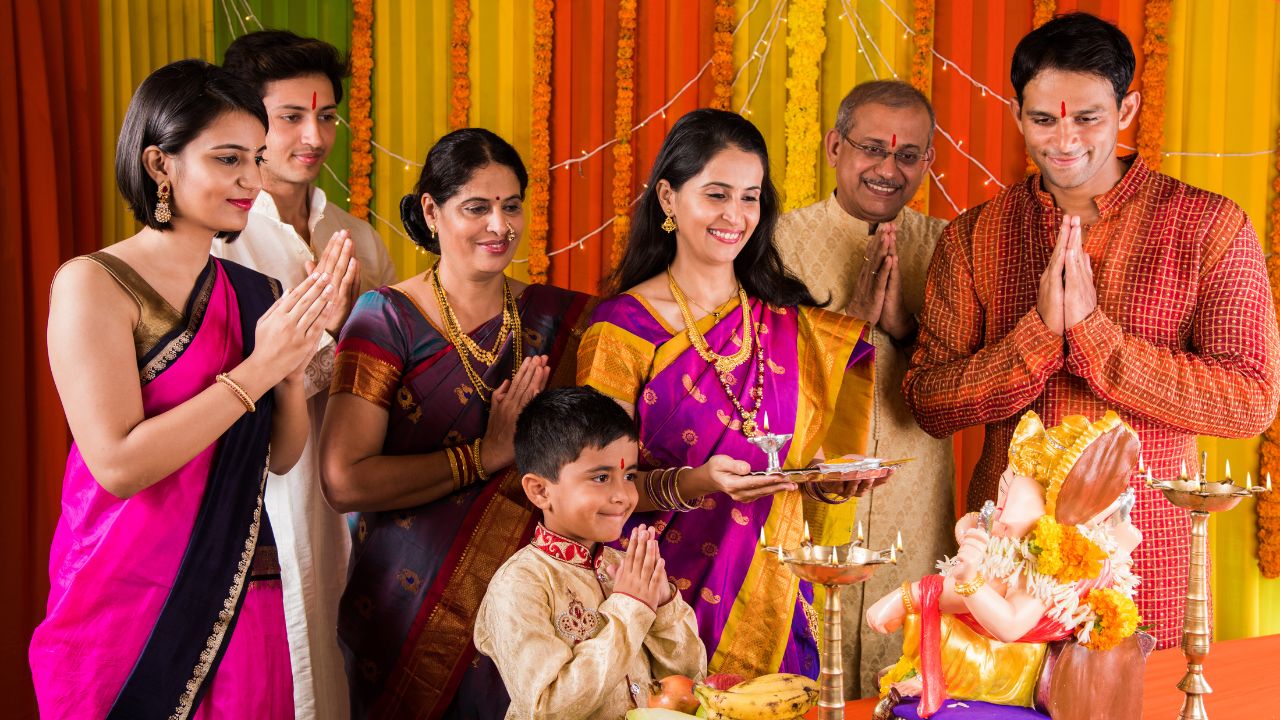Ganesha Chaturthi Puja

Ganesha Puja, also known as “Vinayaka Puja,” is a Hindu religious ritual performed to worship and seek the blessings of Lord Ganesha, the elephant-headed deity who is revered as the remover of obstacles, the god of wisdom, and the patron of arts and sciences. Ganesha Puja can be performed on various occasions, including Ganesha Chaturthi and other festivals, as well as during personal or family ceremonies. Here are the general steps involved in performing a Ganesha Puja:
Before You Begin:
Cleanliness: Ensure that you and the place where you intend to perform the puja are clean and pure.
Idol or Image of Lord Ganesha: You will need an idol or an image of Lord Ganesha as the focal point of your worship. Traditionally, Ganesha idols are made of clay or other eco-friendly materials.
Steps of Ganesha Puja:
Ganesh Sankalpa (Resolve): Begin by taking a sankalpa or resolve, where you mentally declare your intention to perform the puja and seek Lord Ganesha’s blessings.
Pranayama and Prayers: Start the puja by performing pranayama (controlled breathing exercises) to calm the mind and body. Recite prayers and mantras dedicated to Lord Ganesha, such as the “Ganesh Gayatri” or “Om Gam Ganapataye Namaha.”
Offer Flowers and Decorations: Offer fresh flowers, preferably red or yellow, to Lord Ganesha. Decorate the idol or image with flower garlands, sandalwood paste, and vermilion (kumkum).
Light a Lamp: Light a lamp (diya) with ghee or oil and place it in front of the idol as a symbol of enlightenment and spiritual awakening.
Incense and Dhoop: Light incense sticks (agarbatti) and dhoop (fragrant resin) to create a pleasant atmosphere and offer the fragrance to Lord Ganesha.
Offerings (Naivedya): Offer sweets, fruits, and other food items to Lord Ganesha. Modak, a sweet dumpling, is considered his favorite and is often included in the offerings.
Water and Bathing: Sprinkle water on the idol or image of Lord Ganesha as a symbolic bath (abhishekam). You can use water, milk, yogurt, honey, and other liquids.
Chandan and Kumkum: Apply sandalwood paste (chandan) and vermilion (kumkum) on the forehead of Lord Ganesha.
Aarti: Perform the aarti ritual by waving a lit camphor or lamp in front of the idol while singing or reciting aarti songs dedicated to Lord Ganesha.
Prayers and Chants: Continue to recite Ganesha mantras and prayers, such as the “Ganesha Atharvashirsha” or “Ganesha Ashtottara Shatanamavali.”
Blessings and Personal Prayers: Seek Lord Ganesha’s blessings for success, wisdom, and the removal of obstacles. Offer your personal prayers and express your gratitude.
Distribute Prasad: After the puja, distribute the prasad (blessed offerings) to family members, friends, and devotees present during the worship.
Visarjan (Immersion) (if applicable): If you are performing the puja during Ganesha Chaturthi or any other festival involving the immersion of idols, follow the prescribed procedures for visarjan.
Ganesha Puja can be as elaborate or simple as you prefer, depending on your time, resources, and devotion. It is performed with sincerity and devotion to seek Lord Ganesha’s blessings and guidance in various aspects of life.
Related Links
Specific Content Keywords : Lord Ganesha,Ganesh Chaturthi,Puja,Worship,Vinayaka,Modak,Prayers,Offerings,Aarti,Mantras,Idol,Decorations,Fasting,Celebrations,Visarjan,Festival,Devotees,Elephant-headed God,Rituals,Ganapati Bappa Moriya.Lord Ganesha,Ganesh Chaturthi,Puja,Worship,Vinayaka,Modak,Prayers,Offerings,Aarti,Mantras,Idol,Decorations,Fasting,Celebrations,Visarjan,Festival,Devotees,Elephant-headed God,Rituals,Ganapati Bappa Moriya.

